![]()
![]()
![]()
Use LEFT and RIGHT arrow keys to navigate between flashcards;
Use UP and DOWN arrow keys to flip the card;
H to show hint;
A reads text to speech;
157 Cards in this Set
- Front
- Back
|
Name and Number the Axial Skeleton
|
Skull 21 (8 paired and 5 unpaired)
Ossicles of Ears 6 (3 per side) Lower Jaw 1 Hyoid Vertebrae 26 bones Chest 25 bones Total 80 |
|
|
Name and Number the Appendicular skeleton
|
Upper extremities 64 bones
Lower extremities 62 bones Total 126 |
|
|
Define Bone cells
|
Cells the body has programmed to create bones
|
|
|
Define Immature Bone
|
The first formation of bone
|
|
|
Define mature bone
|
Bone that has ossified and calcified
|
|
|
Define Ossification
|
Bone formation
|
|
|
Define Osteoblasts
|
Bone formation
osteoblasts Bone-forming cells that secrete a matrix which becomes calcified |
|
|
Define Osteocytes
|
Former osteoblasts that are surrounded by bone matrix and have calcified
|
|
|
Define Osteoclasts
|
Large multinucleated cells that reabsorb bone matrix
|
|
|
Define Osteoid
|
The matrix in which young bone is formed, as well as the young bone itself that is created
|
|
|
Define Cortical Bone
|
Cortical (compact) bone represents almost 80% of the skeletal mass of the human body. It is called "compact" because it forms a protective outer layer around every bone in the body.
|
|
|
Define Osteon
|
The structural unit of compact bone. Each osteon has a central canal (Haversian canal) containing capillaries, arterioles, venules, nerves, and probably lymphatics.
|
|
|
Define Cancellous Bone
|
(spongy) bone represents about 20% of the skeletal mass, 80% of bone surface. It contains a trabecular (mesh-like) network of bone tissue that allows it to maintain its shape despite compressive forces. does not contain osteons; less dense, very elastic; higher turnover rate
|
|
|
Define Canaliculi
|
The narrow channels through which the osteocytes extend.
|
|
|
Define Lacunae
|
Small cavities containing mature bone cells.(Osteocytes)
|
|
|
Define long bones
|
Long bones are bones whose length is greater than their width
|
|
|
Define short bones
|
Short bones are shaped more like cubes and are generally found in the ankle and wrist
|
|
|
Define flat bones
|
Flat bones are found in the cranial vault, sternum (breastbone), shoulder blades, and ribs. Flat bones are made up of a layer of marrow (diploe) sandwiched between two layers of compact bone.
|
|
|
Define sesamoid bones
|
Sesamoid bones are mostly rounded masses embedded in certain tendons and are usually related to the surfaces of joints. Included in this group are the patella (kneecap), metacarpophalangeal joints of the hands, and metatarsophalangeal joints of the toes.
|
|
|
Define wormian bones
|
Wormian bones are small bones found between suture lines of the skull where the edges of the skull bones are joined together.
|
|
|
Define Sinuses
|
Cavities inside a bone.
|
|
|
Define head of a bone
|
Rounded end of a long bone (the rounded tip).
|
|
|
Define foramen
|
Opening or hole in a bone
|
|
|
Define tubercle
|
Small rounded projections.
|
|
|
Define fossa/groove/pit
|
Indentation of a bone, also called a depression.
|
|
|
Define condyles/
epicondyles |
Rounded bone projections.
|
|
|
Define neck of a bone
|
Constricted end of a long bone before the head or rounded end.
|
|
|
Define canal/meatus
|
Long or deep hole in a bone.
|
|
|
Define facets
|
Small, smooth, and flat areas.
|
|
|
Elastic fibers are composed of what 2 proteins?
|
elastin - protein that forms the core of each fiber
fibrillin - a glycoprotein that forms a thin mantle of microfibrils around the elastin protein core |
|
|
Define anterior fontanel
|
The space where the frontal angles of the parietal bones meet the two ununited halves of the frontal bone.
|
|
|
Define posterior fontanel
|
The space where the occipital angles of the parietal bones meet the occipital.
|
|
|
Define anterolateral fontanels
|
An interval on either side of the head where the frontal angle of the temporal bone and greater wing of the sphenoid meet.
|
|
|
Define posterolateral fontanels
|
The interval on either side of the head between the mastoid angle of the parietal bone, the temporal bone, and the occipital bone.
|
|

|
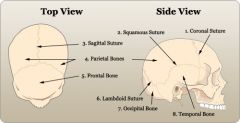
|
|

|
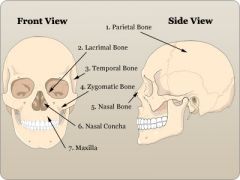
|
|
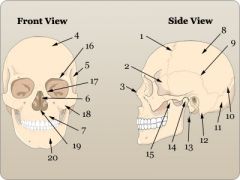
|

|
|
|
Name 2 bones of the cranium that cannot be depicted
|
Palatine bone is the bone of the “roof of the mouth”
The ethmoid bone separates the nasal cavity from the brain |
|
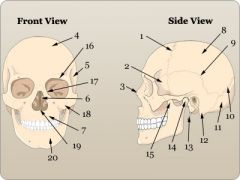
|

|
|
|
Name and Describe the Ossicles of the Ear
|
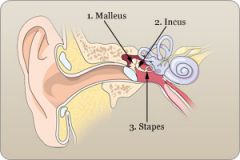
|
|
|
Name and Describe and Jaw and Neck Bones
|
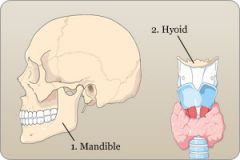
|
|
|
Name the 8 sections of the Vertebral Column?
|
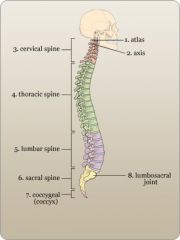
|
|
|
Difference between Concave and Convex
|
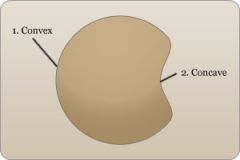
|
|
|
Define Articulate
|
Loosely connect or join. The 12 vertebrae of the thoracic spine articulate to the 12 ribs to form protection for the thoracic cavity.
|
|
|
Define intervertebral discs
|
Intervertebral disks (also correctly spelled discs) are composed of fibrous tissue and cartilage located between the vertebrae. Their function is to form strong joints and absorb spinal compression and shock.
|
|
|
Define Sternal Angle
|
Area of sternum where the manubrium and body join.
|
|
|
Name and Describe the 12 Strenum and Rib Bones
|

|
|
|
Name and Describe the Scapula
|
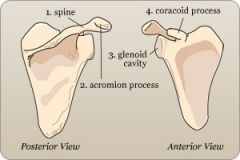
|
|
|
Define Olecranon
|
The large process at the proximal end of the ulna which projects behind the articulation with the humerus and forms the bony prominence of the elbow.
|
|
|
Define Trochlear Notch
|
Pulley-shaped structure of the elbow
|
|
|
Define radial notch
|
Point at which the radius and ulna articulate.
|
|
|
Name the Hand and Wrist Bones (8 Carpal Bones)
|
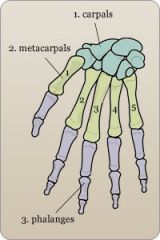
The 8 carpal bones are the hamate, scaphoid, trapezium, pisiform, trapezoid, lunate, triquetrum, and capitate bones.
|
|
|
Name and Describe the 3 Phalanges
|
There are 5 fingers, and each has 3 phalanges (the distal, medial, and proximal phalanges), with the exception of the thumb, which has only 2.
|
|
|
Name and Describe the 11 Bones of the Hip
|
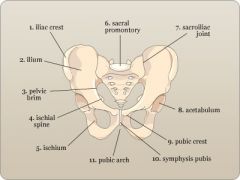
|
|
|
Name and Describe the Leg and Foot Bones (7 tarsal bones)
|
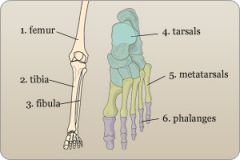
There are 7 tarsal bones in each foot: the talus, calcaneus, cuboid, navicular, and 1st, 2nd, and 3rd cuneiforms.
|
|
|
transverse arch
|
Formed at the base of the metatarsals, extending from the medial to the lateral sides of the foot
|
|
|
medial longitudinal arch
|
Predominant arch, running from the base of the calcaneus to the talus, and down to the three medial metatarsals
|
|
|
lateral longitudinal arch
|
Arches just enough to redistribute body weight to the calcaneus and head of the fifth metatarsal
|
|
|
. calcaneus
|
Heel bone; the strongest bone in the foot
|
|
|
fibrous joints
|
No joint cavity and, in general, do not move.
|
|
|
cartilaginous joints
|
Have no cavities and are somewhat moveable.
|
|
|
synovial joints
|
Have joint cavities that are kept lubricated by synovial fluid.
|
|
|
plane joints
|
Joints that glide where the flat ends of bones connect.
|
|
|
uniaxial joints
|
Allow movement around one axis only.
|
|
|
biaxial joints
|
Allow movement around two axes.
|
|
|
multiaxial joints
|
Allow movement around three axes.
|
|
|
flexion
|
Bending to decrease the angle between two bones. Think of this as “flexing” the biceps.
|
|
|
extension
|
Unbending to increase the angle between two bones. Think of this as extending, as in reaching your arm as far as you can.
|
|
|
abduction
|
Moving a body part away from the midline.
|
|
|
adduction
|
Moving a body part toward the midline.
|
|
|
circumduction
|
Movement of a body part in a circle, which can include all the above joint movements as well.
|
|
|
accessory ligament
|
Any ligament that strengthens or supports another ligament.
|
|
|
arcuate ligament
|
Means curved or bow-shaped ligaments; they are located in the spine and assist in maintaining the erect position. (Also called ligamenta flava [plural], and ligamentum flavum [singular].)
|
|
|
collateral ligament
|
There are several types of collateral ligaments, including fibular, radial, tibial, ulnar, etc. These are basically ligaments that are not direct, but are supporting ligaments.
|
|
|
coracoid ligament
|
Coracoid means like a raven’s beak and is used to describe an area on the scapula. It is so named for its shape.
|
|
|
cruciate ligament
|
Cruciate means shaped like a cross. There are different types of cruciate ligaments, including anterior, posterior, and lateral. They appear in many places in human anatomy, such as the knees, fingers, and toes.
|
|
|
falciform ligament
|
Falciform means shaped like a sickle and appears near the sacral tuberosity as well as within the liver.
|
|
|
inguinal ligament
|
Inguinal is a term used to describe the groin area.
|
|
|
interosseous ligament
|
Interosseous means between bones and describes several different ligaments.
|
|
|
longitudinal ligament
|
Longitudinal simply means lengthwise. It is used to describe any ligament that runs lengthwise.
|
|
|
nuchal ligament
|
Nuchal means pertaining to the neck.
|
|
|
triquetral ligament
|
Triquetral means three cornered and appears in different places throughout the body. The prefix tri- should be familiar as meaning three.
|
|
|
apophyseal f.
|
A fracture in which a small fragment is torn from the bone.
|
|
|
articular f.
|
A fracture of the joint surface.
|
|
|
avulsion f.
|
An indirect fracture caused by tearing or pulling of a ligament.
|
|
|
blow-out f.
|
A fracture of the orbital floor caused by traumatic force.
|
|
|
boxer f.
|
Fracture of the metacarpal neck, caused by striking something hard with a closed fist.
|
|
|
bucket-handle f.
|
Also called a "bucket-handle tear," it is a tear in the cartilage and it leaves a loop of cartilage lying in the intercondylar notch.
|
|
|
burst f.
|
Also called an "axial compression fracture," it is a fracture of a vertebra, often injuring the spinal cord.
|
|
|
butterfly f.
|
A comminuted fracture resulting in two fragments of bone on either side of a main fragment; the result resembles a butterfly.
|
|
|
buttonhole f.
|
Also called a "perforating fracture," it results when a bone is perforated by a missile.
|
|
|
chisel f.
|
Detachment of a piece from the head of the radius.
|
|
|
cleavage f.
|
Shelling off of cartilage by a small fragment of bone.
|
|
|
closed f.
|
A fracture that does not penetrate or produce an open wound in the skin.
|
|
|
Colles' f.
|
Fracture of the lower end of the radius, where the fragment is displaced.
|
|
|
comminuted f.
|
A fracture in which the bone is splintered or crushed.
|
|
|
complete f.
|
A fracture in which the bone is entirely broken all the way across.
|
|
|
complicated f.
|
When there is injury to adjacent parts of the bone due to a fracture.
|
|
|
compound f.
|
Basically just an open fracture.
|
|
|
compression f.
|
A fracture as a result of compression.
|
|
|
condylar f.
|
A fracture of the humerus where a small fragment that includes the condyle is separated from the bone.
|
|
|
dislocation f.
|
A fracture that occurs near a joint and results in displacement of the joint.
|
|
|
greenstick f.
|
Also called "hickory-stick fracture," it is a fracture in which one side of the bone is broken and the other side is bent.
|
|
|
hangman's f.
|
A fracture through the axis (C2).
|
|
|
impacted f.
|
When one fragment of a fracture is driven into another.
|
|
|
indirect f.
|
A fracture that occurs at a point distant from the injury.
|
|
|
insufficiency f.
|
A stress fracture that occurs when there is a normal amount of stress, but the bone is of decreased density.
|
|
|
intra-articular f.
|
A fracture on the articular surface of a bone (also acceptably presented as intraarticular.)
|
|
|
intracapsular f.
|
A fracture occurring within the capsule of a joint.
|
|
|
intrauterine f.
|
Fracture of a fetal bone while in utero.
|
|
|
Le Fort f.
|
Fracture of the maxilla. (There are different types of Le Fort fractures; they are dictated "Le Fort 1, 2, or 3" and are transcribed as Le Fort I, Le Fort II, and Le Fort III.)
|
|
|
linear f.
|
A fracture extending along the length of a bone.
|
|
|
longitudinal f.
|
A break extending in a longitudinal direction.
|
|
|
oblique f.
|
A break extending in an oblique direction.
|
|
|
open f.
|
A fracture that results in an external wound (i.e., a portion of the fractured bone protrudes through the skin).
|
|
|
simple f.
|
Opposite of a compound fracture; basically a closed fracture.
|
|
|
spiral f.
|
Also called a "torsion fracture," it is where a bone is literally twisted apart.
|
|
|
spontaneous f.
|
Occurs as a result of some longstanding disease and is not traumatic.
|
|
|
stress f.
|
Caused as a result of repeated stress to a bone (commonly seen in soldiers or athletes).
|
|
|
subcapital f.
|
A fracture of a bone just below its head.
|
|
|
torsion f.
|
Also called a "spiral fracture." it is where a bone is literally twisted apart.
|
|
|
torus f.
|
A fracture with localized expansion of the cortex, but little or no displacement of the lower end of the bone.
|
|
|
transverse f.
|
A fracture that occurs at a right angle to the axis of a bone.
|
|
|
tuft f.
|
A splintered fracture of the distal phalanx.
|
|
|
achondroplasia
|
A hereditary disorder of cartilage and bone formation.
Symptoms are disproportionately short limbs. |
|
|
ankylosing spondylitis
|
This is a rheumatoid arthritis of the spine. It is progressive and is found most often in young men, affecting the intervertebral joints, the sacroiliac joints, and the costovertebral joints.
Symptoms are back pain and early morning stiffness relieved by activity. |
|
|
arthritis
|
This affects joints and is the inflammation of one or more joints. There are many types. The most common is osteoarthritis.
Symptoms include joint pain, swelling, stiffness, deformity, fever, and weight loss. |
|
|
inflammation
|
Arthritis is the inflammation of one or more joints.
|
|
|
rheumatoid
|
A type of arthritis characterized by inflammatory changes throughout the body's connective tissues.
|
|
|
chondrosarcoma
|
This is a malignant tumor of cartilage.
Symptoms include pain and generally the presence of a mass. |
|
|
degenerative joint disease
|
Joint disease characterized by degeneration of the articular cartilage.
Symptoms include pain and stiffness in joints which is aggravated with physical activity and relieved with rest. |
|
|
Ewing tumor
|
This is a cancerous tumor or malignancy that invades the entire shaft of the bone.
Symptoms include pain and swelling. |
|
|
sarcoma
|
A connective tissue tumor that is usually malignant.
|
|
|
gout
|
A systemic disease due to deposition of urate crystals.
Symptoms include episodes of severe pain and swelling, usually affecting a single joint. |
|
|
Hurler syndrome
|
This is caused by irregular ossification and is due to an overproduction of mucopolysaccharides.
Symptoms include short stature, coarse features, skeletal deformities, enlarged organs. |
|
|
muco-
polysaccharides |
An antiarthritic compound that effectively increases the viscosity (or stickiness) of synovial fluid.
|
|
|
hypo-
phosphatasia |
This condition is a result of a deficiency in alkaline phosphatase.
Symptoms include skeletal defects, bone pain, and other abnormal body chemistries. |
|
|
alkaline phosphatase
|
Enzyme produced in the bone and liver.
|
|
|
Legg-Calve-
Perthes disease |
Disease of the hip joint that results in a loss of bone mass due to inadequate blood flow to the joint.
Symptoms include hip or groin pain which is aggravated with physical activity. A limp is often the result of the severe pain. |
|
|
Marfan syndrome
|
This results from abnormal formation of connective tissue.
Symptoms include long, slender habitus, skeletal malformations, and vision/eye problems. |
|
|
multiple myeloma
|
This is the most common bone neoplasm. It is a tumor derived from the blood cells.
Symptoms include pain and swelling. |
|
|
Osgood-Schlatter disease
|
This disease affects the tibial tubercle, where the patella inserts onto the tibia. It manifests itself when growth centers become stressed (usually due to physical/athletic activity).
Symptoms include limping and pain at the site upon exertion. |
|
|
osteochondritis dissecans
|
This is the term for osteochondrosis (see below) involving the joints, particularly the shoulder and knee joints.
|
|
|
osteochondrosis
|
a group of developmental disorders that affect ossification centers and usually occur in adolescence. Some of these include Legg-Calve-Perthes disease, Osgood-Schlatter disease, and Scheuermann disease. Major symptoms include pain and limited movement of the affected joints or bones.
|
|
|
osteogenesis imperfecta
|
This is also a result of abnormal formation of connective tissues.
Symptoms include blue sclerae, fractures as a result of very minor trauma, and deafness. |
|
|
osteoid osteoma
|
This is a benign lesion that can occur in any bone, but is most common in the long bones.
Symptoms include skeletal deformities, bowing of long bones, and hypertrophy of epiphyses. |
|
|
osteomalacia
|
This is softening of bone as a result of the bone being poorly mineralized.
Symptoms include deformities and fractures of bones. |
|
|
osteomyelitis
|
This is usually a bacterial infection of the bone, although it can also be a fungal infection. The most common pathogen is the bacteria Staphylococcus aureus.
Symptoms include the onset of bone pain, fever, and chills. (Incidentally, most infections are recognizable by the presence of fever and chills.) |
|
|
Staphylococcus aureus
|
Bacteria of the genus Staphylococcus, it is found in nasal membranes, skin, hair follicles, and perineum.
|
|
|
osteoporosis
|
This occurs when the density of the bone is inadequate to allow for the proper support required of bone.
Symptoms include backache, loss of height, and forward hunching of the spine (which is called kyphosis). |
|
|
kyphosis
|
Forward hunching of the spine.
|
|
|
Paget disease
|
A degenerative disorder of the bone resulting in the softening and swelling of bone.
Symptoms include bone pain, kyphosis, bowing of the shins, and cranial swelling. (The cranial swelling specifically can lead to deafness.) |
|
|
psoriatic arthritis
|
Psoriasis is a chronic skin disease which causes scaling, dryness, pustules, and abscesses to appear on the nails, scalp, lumbar area of the spine, and genitalia. This can lead to joint involvement, which is psoriatic arthritis.
|
|
|
Reiter syndrome
|
This is an arthritis associated with nonbacterial urethritis, conjunctivitis, cervicitis, and mucocutaneous lesions. conjunctivitis is the most common lesion of the eye, and mucocutaneous lesions are superficial ulcers.
|
|
|
rickets
|
Occurs in infants as a result of overgrowth of poorly mineralized bone and enlarged marrow cavities.
Symptoms include skeletal deformities, bowing of long bones, and hypertrophy of epiphyses. |
|
|
Scheuermann disease
|
This disease specifically affects the ossification centers of the vertebrae.
Symptoms include juvenile kyphosis, or a curved appearance of the spine. |
|
|
scoliosis
|
Scoliosis is lateral (or sideways) curvature of the spine in the erect position. It is caused by malalignment of the vertebrae.
|

